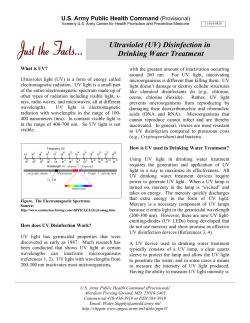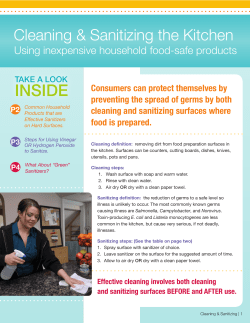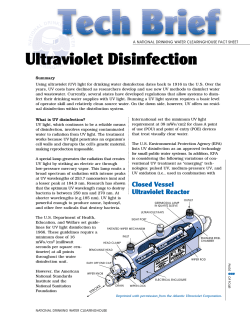
Drinking Water Chlorination
Drinking Water Chlorination The use of chlorine to protect drinking water is one of the greatest public health advances in history. Chlorine destroys disease-causing organisms in water and is the most commonly-used disinfectant in all regions of the world. The World Chlorine Council® (WCC) has published this paper to briefly address key issues related to drinking water chlorination: • Chlorine’s critical role in providing safe drinking water around the globe; • Potential health and environmental effects of chlorine and disinfection byproducts in treated drinking water; and • Considerations for selecting disinfection methods. The World Chlorine Council (WCC) is a global network representing the chlorine and chlorinated products industries. Formed in 1993, the WCC currently represents over 23 national/regional associations in over 27 countries accounting for over 80 percent of global chlorine production. The WCC works to improve awareness of the benefits of chlorine chemistry; further the practice and understanding of responsible stewardship; and anticipate and respond to relevant health, environmental and public policy issues. 2 Drinking Water Chlorination • World Chlorine Council position paper 2008 Helping to provide safe drinking water around the globe Chlorine is effective, affordable, and widely available for disinfection Chlorine is used to destroy disease-causing organisms in water, an essential step in delivering safe drinking water and protecting public health. Chlorine is by far the most commonly used disinfectant in all regions of the world. Where widely adopted, chlorine has helped to virtually eliminate waterborne diseases such as cholera, typhoid and dysentery. Chlorine also eliminates slime bacteria, molds and algae that commonly grow in water supply reservoirs, on the walls of water mains and in storage tanks. Only chlorine-based disinfectants leave a beneficial “residual” level that remains in treated water, helping to protect it during distribution and storage. Chlorine is a versatile and low-cost disinfectant appropriate for any size water system, whether it serves a remote rural village or a large modern city. Where piped water supplies are not available, chlorine can also be used for treating water in individual households. Specially-packaged chlorine bleach can disinfect household water for less than US $4/year per family. In addition, chlorine is critically needed for emergency relief efforts. In responding to the 2004 tsunami disaster in South Asia, the World Health Organization (WHO) reported, “Chlorine is most widely and easily used, and the most affordable of the drinking water disinfectants. It is also highly effective against nearly all waterborne pathogens.” Water and sanitation: A global health crisis More than one billion people do not have access to a safe water supply within 1 km of their homes, relying instead on unprotected lakes, streams or shallow wells to meet household needs. Even where relatively clean water is available at a community source, it can easily be contaminated as it is collected, carried and stored in the home. WHO estimates that more than 4,000 people die each day from diarrhoeal diseases resulting from unsafe water and lack of sanitation. Ninety percent are children under the age of five who live in developing countries. Safe water: Essential for sustainable development The United Nations has recognized the critical link between safe water and sustainable development. Access to safe water not only reduces disease, but also provides a range of economic benefits for a community. At the 2002 World Summit on Sustainable Development, the United Nations reaffirmed its commitment to reduce by one-half the proportion of people without access to safe water by 2015. Meeting this goal will require sustained, coordinated action and enormous investments each year. WHO has concluded that global investments to improve access to safe water access will yield direct and indirect benefits that far exceed the associated costs. Drinking Water Chlorination • World Chlorine Council position paper 2008 3 Chlorine and disinfection byproducts in drinking water do not pose significant health or environmental risks Chlorine in drinking water is safe for consumption The small amount of chlorine typically used to disinfect water does not pose risks to human health. The World Health Organization (WHO) has established a guideline value of 5 mg/L for chlorine in drinking water, meaning that such concentrations are considered acceptable for lifelong human consumption. Furthermore, WHO concludes that this value is “conservative,” as no adverse effects from chlorine in drinking water were observed in studies reviewed by WHO. DBPs should be controlled, but disinfection must never be compromised Another safety consideration for treated drinking water is disinfection byproducts (DBPs), chemical compounds formed unintentionally when chlorine and other disinfectants react with certain organic matter in water. All disinfectants form DBPs, although much more is known about chlorination byproducts than is known about the byproducts of other disinfectants. For example, toxicological studies suggest that some trihalomethanes (THMs) are carcinogenic to laboratory animals, but only at levels many thousands of times greater than those found in drinking water. Research has shown that chloroform (the main type of THM) is unlikely to cause cancer at extremely low levels found in drinking water. While the potential health risks from DBPs are small and uncertain, high levels of these chemicals are certainly undesirable. WHO has established guideline values for several DBPs, including trihalomethanes. Guideline values for chlorine and trihalomethanes WHO Guidelines for drinking water quality (2004) Chlorine below 5 milligrams per liter (mg/L)* Bromodichloromethane below 0.06 mg/L Bromoform below 0.10 mg/L Chloroform below 0.20 mg/L Dibromochloromethane below 0.10 mg/L * For effective disinfection, there should be a residual concentration of free chlorine of 0.5 mg/L after at least 30 min contact time at pH<8.0 4 Drinking Water Chlorination • World Chlorine Council position paper 2008 DBP formation can be reduced through cost-effective methods, particularly by reducing the amount of natural organic material in water (through filtration or other means) prior to disinfection. WCC supports adoption of these methods whenever possible. However, as WHO strongly cautions: “The health risks from these byproducts at the levels at which they occur in drinking water are extremely small in comparison with the risks associated with inadequate disinfection. Thus, it is important that disinfection not be compromised in attempting to control such byproducts.” A stark example of the importance of water disinfection is the cholera epidemic that began in Peru in 1991, and spread to 19 Latin American countries. Inadequate disinfection of municipal water supplies was a major factor contributing to the spread of the epidemic that caused more than one million illnesses and 12,000 deaths. During the outbreak, officials with the Pan American Health Organization reported that concerns about potential health risks from disinfection byproducts led municipalities and communities in the region to abandon chlorination. One official later wrote, “Rather than being abated by increase use of chlorination, the waterborne transmission of cholera was actually aided because of worries about chlorination byproducts.” Chlorination does not harm aquatic environments Chlorinated drinking water is unlikely to be harmful when discharged into aquatic environments. An extensive risk assessment conducted under European Union guidelines examined potential harm from various processes to make drinking water using sodium hypochlorite. This assessment found no significant environmental risks from chlorine or byproducts formed during drinking water chlorination. The DBPs formed in drinking water depend on the nature and quantity of organic matter present as well as on the disinfectant and other treatments used. In drinking water the principal byproducts are trihalomethanes (THMs; mainly chloroform) and haloacetic acids (HAAs), with smaller amounts of other byproducts. Direct ‘whole effluent’ experiments representing various uses, including drinking water, have shown that no significant amounts of persistent and potentially bioaccumulative substances are formed. Toxicity tests on these mixtures demonstrated that the presence of DBPs did not increase the toxicity. A major concern from the past was the formation of some highly-chlorinated, high-hazard molecules, such as dioxins, resulting from chlorine used in paper pulp bleaching. However, dioxins were only formed from ‘active chlorine’ under specific conditions: acid pH and in the presence of certain phenols such as those abundant in the lignin component of wood. There is no significant formation of dioxins or other high-hazard molecules at neutral or alkaline pH. All current uses of ‘active chlorine’ for microbial control and cleaning take place at alkaline or neutral pH. Drinking Water Chlorination • World Chlorine Council position paper 2008 5 Disinfection technologies must be effective, affordable and appropriate for local conditions Various technologies are available Chlorination is the most widely used disinfectant, both in centralized water distribution systems and for point-of use treatment in individual households. Its effectiveness against a wide spectrum of disease-causing organisms, relatively low cost and high reliability contribute to its popularity. Chlorine is applied to water either as elemental chlorine (chlorine gas), or through the use of chlorinating chemicals such as calcium hypochlorite (tablets or granules) or solutions of sodium hypochlorite (liquid bleach). While varying in form and concentration, each produces “free chlorine” to attack germs in water. The level of free chlorine can be easily monitored, providing an important measure of water quality. A “residual” level of chlorine helps protect treated water treated water in the distribution system, particularly important for older water systems. A number of alternative methods are available for drinking water disinfection. These include: ozone, a powerful disinfecting agent generated by passing oxygen or dry air through a system of high voltage electrodes; chlorine dioxide, a powerful chemical that contains chlorine molecules, but disinfects through a different mechanism than free chlorine; and ultraviolet (UV) radiation, a non-chemical method to disinfect water using light generated by special lamps. In addition, some harmful microorganisms can be removed from water though filtration or other physical means. Filtration methods range from simple sand filters for household treatment, to reverse osmosis systems in state-of-the-art treatment plants. Each disinfection technology has unique strengths and limitations. No single disinfection method is right for all circumstances, and in fact, a multi-step process may be appropriate to meet overall treatment goals. 6 Drinking Water Chlorination • World Chlorine Council position paper 2008 Considerations for selecting disinfection methods Efficacy against pathogens — Controlling microbial contamination must always be given primary importance. While chlorine is effective against most pathogens, additional treatment steps may be needed where resistant organisms such as Cryptosporidium or Giardia are a concern. Laws and regulations — Treatment processes and final drinking water quality must meet local standards. Source water quality — The characteristics of local source water, such as turbidity and organic load, will impact disinfection requirements. Residual protection — Only chlorine-based products provide a “residual” level of disinfectant that remains in water to prevent microbial re-growth and help protect treated water during distribution and storage. Therefore, no other disinfection method by itself can protect water all the way to the tap. Local capacity — Sufficient resources, supplies and training must be available to maintain service after treatment technologies are adopted. Safety — All disinfection chemicals require proper storage and handling practices. Safety guidelines are available from national and regional chlorine associations. Consumer expectations — Educational efforts may help local communities understand the need for water disinfection, and ensure acceptance of treatment methods. Affordability — Water service and/or home treatment products must be affordable to consumers. Drinking Water Chlorination • World Chlorine Council position paper 2008 7 WCC members Producer Associations Asociacion Nacional de la Industria Quimica (Mexico) www.aniq.org.mx/ Canadian Chlorine Chemistry Council www.cfour.org Chlorine Chemistry Division of the American Chemistry Council www.americanchemistry.com/chlorine Chlorine Institute www.cl2.com Clorosur www.clorosur.org Euro Chlor www.eurochlor.org Indian Chemical Manufacturers Association Japan Soda Industry Association www.jsia.gr.jp Korea Chlor-Alkali Association Plastics and Chemicals Industries Association of Australia www.pacia.org.au Taiwan (China) Acid & Alkali Industry Association Product Sector Associations Asia-Pacific Vinyl Network European Council of Vinyl Manufacturers www.ecvm.org Halogenated Solvents Industry Alliance www.hsia.org Vinyl Council of Australia www.vinyl.org.au Vinyl Council of Canada www.plastics.ca/vinyl Vinyl Environmental Council (Japan) www.vec.gr.jp Vinyl Institute www.vinylinfo.org Corresponding Associations RusChlor, the Russian chlor-alkali association China Chlor-Alkali Industry Association [pending] www.worldchlorine.org info@worldchlorine.org
© Copyright 2025





















